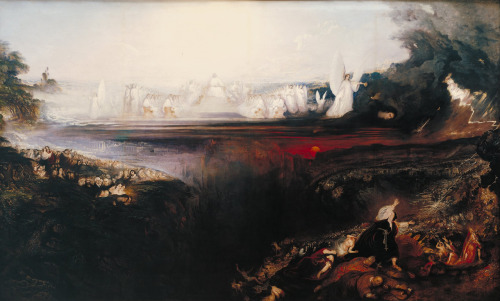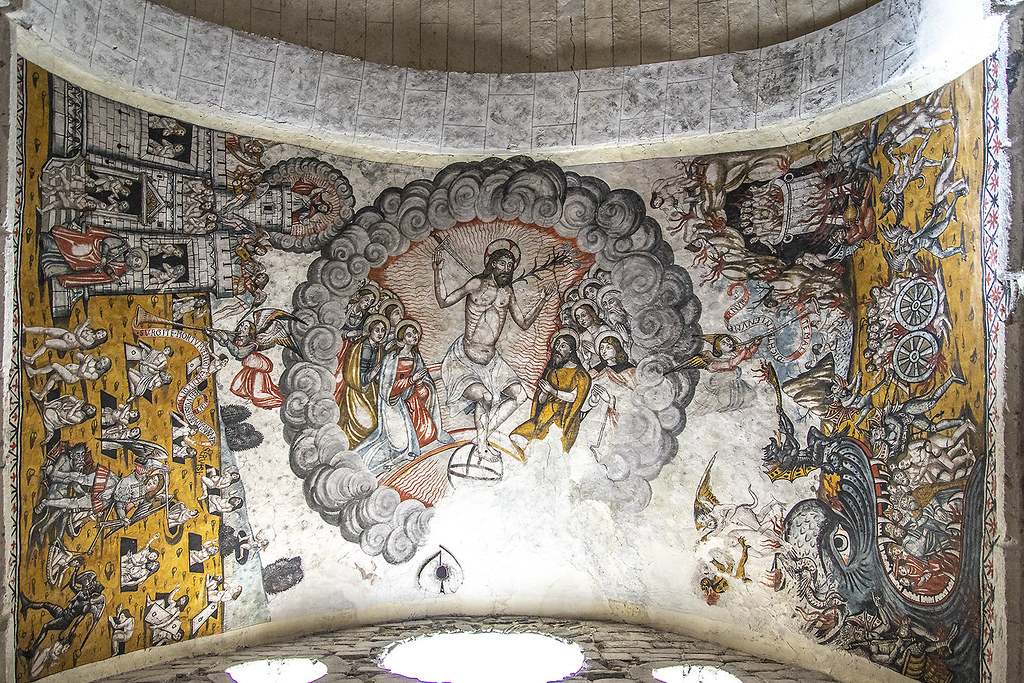#last judgement
HOMILY for First Sunday of Advent ©
Jer 33:14-16; Ps 24; 1 Thess 3:12-4:2; Luke 21:25-28, 34-36

Many people think that Advent, which means ‘coming’, is about getting ready for Christ’s First Coming, what we call ‘Christmas’. In fact the first period of Advent is much more concerned with readying us for Christ’s Second Coming. For on the Last Day the Lord will come, not hidden and in meekness as he did at Bethlehem over two thousand years ago, but rather he shall come “with power and great glory”, as we hear in today’s Gospel. One of the great Wesleyan hymns for Advent thus says: “Ev’ry eye shall now behold him, robed in dreadful majesty…” And then the hymn continues – in a verse that is, unfortunately, seldom sung these days – but which is clearly inspired by today’s Gospel: “Ev’ry island, sea, and mountain, heav’n and earth, shall flee away; all who hate him must, confounded, hear the trump proclaim the day: Come to judgement! Come to judgement! Come to judgement, come away!”
Advent, therefore, begins, not quietly and in hushed silence, as one might expect if it were simply about the coming of the Babe of Bethlehem. But, as it is concerned about our readiness for the coming of Christ as our Judge. So it begins by sounding the alarm, as it were, with the prophet Jeremiah calling us to “practise honesty and integrity”, that is to say, to live up to our Christian calling. Hence the apostle St Paul says: “we urge you and appeal to you in the Lord Jesus to make more and more progress in the kind of life that you are meant to live: the life that God wants.” The goal, as he says, is that, by God’s grace, we should be “blameless in the sight of our God and Father when our Lord Jesus Christ comes with all his saints.”
Who among us can say that we shall be found blameless on the Day of Judgement? None of us, I fear! So, there is an urgency behind St Paul’s words, and throughout this Advent season – not so much about getting the Christmas shopping and cards and preparations done – but rather, much more importantly, that we should be prepared for Christ’s return as Judge. And on that day, as St John of the Cross says, we shall be judged by Love. Hence St Paul prays that we will increase in love, that means, a Christ-like sacrificial love for one another (our fellow Christians), and even for the whole human race.
The purple colour of Advent, the more sombre tones and music of this season, thus all serve to remind us of the penitential aspects of this season. For nobody, when thinking of the Last Judgement and of how little we love and how far from blameless we are, can fail to do penance during Advent. We are called, therefore, to examine our consciences, consider the kind of life we’re meant to live as Christians, and so to go to confession and receive the graces we need. For God desires, through the sacraments, to increase our love. Hence, next Saturday, on the first Saturday of the month, we have our customary first Saturday devotions in which we’ve been asked by Our Lady of Fatima to go to confession, make reparation for sin, and to pray the Rosary. Indeed, here in the Rosary Shrine, we have regular scheduled times for confession every single day of the week, so please do take up the opportunity. For as the Lord says: “that day will be sprung on you suddenly, like a trap.” So, if we wish to “stand with confidence before the Son of Man” when he returns to judge the living and the dead, so we must be prepared through penance and frequent recourse to the Sacrament of Confession.
However, I believe there is a different character to the penitence of Advent that distinguishes it from Lent. There is, it seems to me, an element of deep joy and the expectation of our redemption. As the Lord says in the Gospel: “when these things begin to take place, look up and raise your heads, because your redemption is drawing near.” (Lk 21:28) So, we are not to hang our heads in shame, but to raise our heads in joyful hope of God’s salvation. For, by our repentance and thus throwing off the works of darkness, we have been shown the mercy of God, and we can then have a renewed hope in God’s salvation.
The result of this work of redeeming grace in our souls, a grace that stirs us to repentance and to the renewal of our lives, is that we now long for Christ’s return, indeed, we look forward to it. Just as children look forward to Christmas, so the Christian who has become like a little child in his humility and obedience to the demands of the Gospel, can also look forward to Christ’s Second Coming with great eagerness and hope. Therefore, as the season of Advent advances, and indeed, as our own Christian lives progresses in years, we should increasingly look up as we bask in the light of the Lord, looking out for the coming splendour of the Day of his Coming.
For as St Paul says to the Romans: “salvation is nearer to us now than when we first believed”! (Rom 12:11) So, just as a child waits for Christmas morning, so we Christians stand ready and awake, looking up with joy, waiting for the coming of the Lord Jesus. Therefore the chorale of a beautiful Bach cantata that I enjoy listening to every Advent Sunday, Wachet auf, sings out with these words: “Zion hears the watchmen sing, her heart leaps for joy, she awakes and gets up in haste. Her friend comes from heaven in his splendour, strong in mercy, mighty in truth.”
Yes, Christ, our friend shall come to us in splendour, strong in his mercy and mighty in his truth. This Advent, let us seize the day, and deepen our experience of the strength of God’s mercy, above all through the Sacrament of Confession, and of the might and power of his truth, which is that Christ has come to make us his Saints. He accomplished this by his First Coming on the first Christmas day; he will complete it at his Second Coming when he comes as Judge; and he comes to us every day through grace, through the gift of the Sacraments, by which he works within us to cause us to increase and grow in genuine Christian love. Therefore, for these beautiful comings of the Lord Jesus, his advent in our heart, we cry out: Maranatha, which means, Come, Lord Jesus!



Fürstenportal (prince’s porch) of Bamberg Cathedral, Germany.
.
around 1225.
These people might look like they are smiling but there is no happiness depicted. They are the damned of the Last Judgment drawn by the devil with a thick chain. Their faces show despair and fear (in the medieval understanding).
This depiction of the Last Judgement in St. Sophia Cathedral (Vologda) dates from the 17th century.
(Photo by Happykg, via Wikimedia Commons)
Post link
Iglesia de Santa María de Artiés / Church of Santa María de Artíes, Artiés, Spain, about 1580 (church dates back to the 12th century)
Photo: La magia de la luz
Hans Memling
Last Judgement
1467-71
Oil on panel
Commissioned by Angelo Tani, an Italian banker with the Medici bank in Bruges. The kneeling figure being weighed by St. Michael is believed to be Tommaso Portinari, who took over Tani’s position at the bank in Bruges. Portinari, along with members of his family, can be seen in donor portraits in Hugo van der Goes’s Portinari Altarpiece, c. 1475.
This painting is in the collection of Poland’s National Museum in Gdańsk. Image taken from Wikipedia.
Post link
Rijksmuseum, Amsterdam, 1960’s. Photo by Fritz Henle
A visitor in front of The Last Judgement, 1617 painted by Peter Paul Rubens
Post link
Amiens, Last Judgement Tympanon, Bisson Frères, 1858
albumen print from glass negative on original mount
Post link








